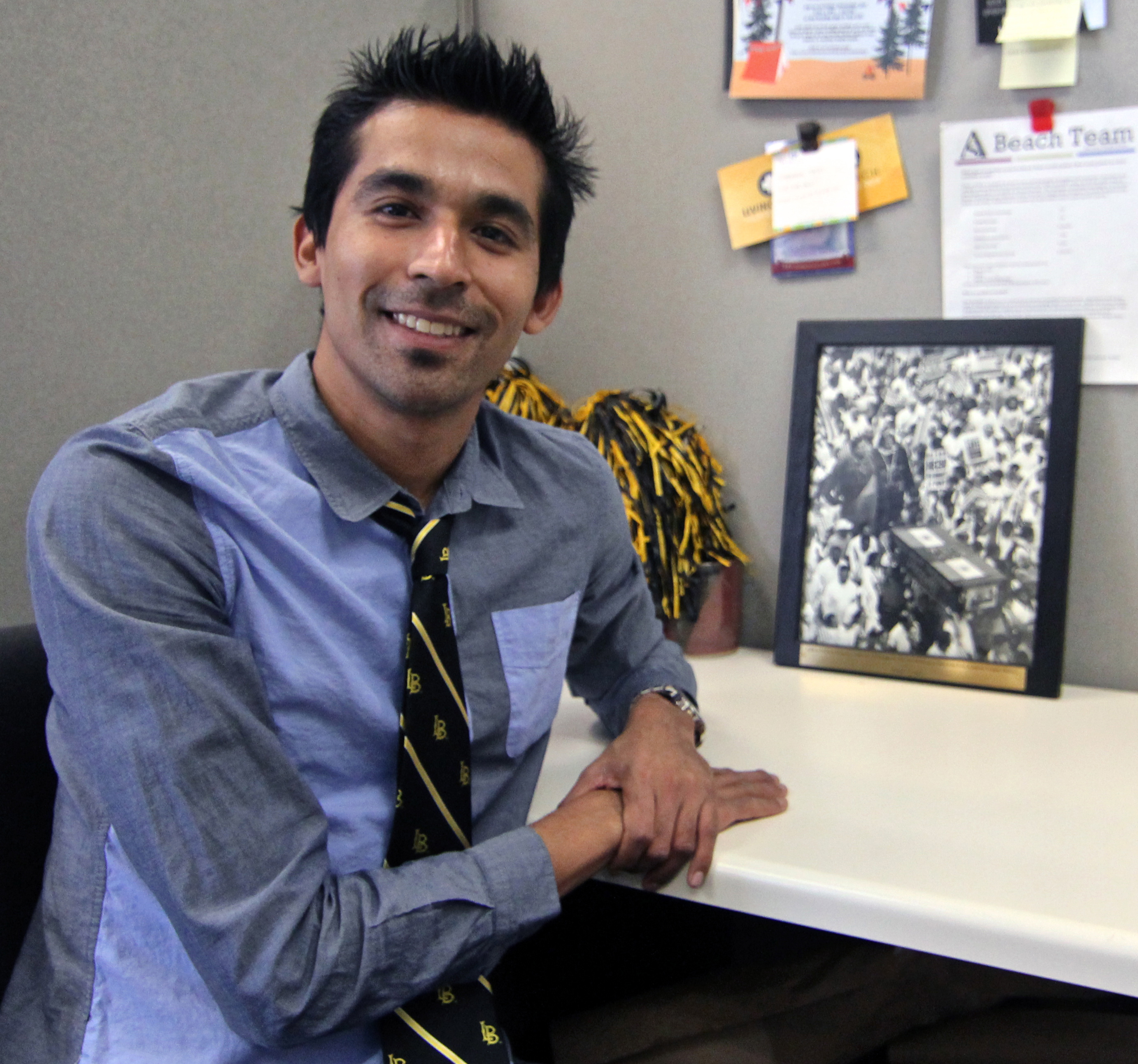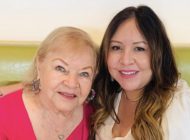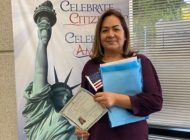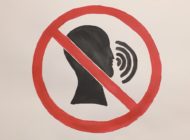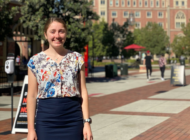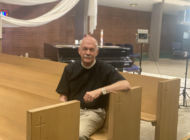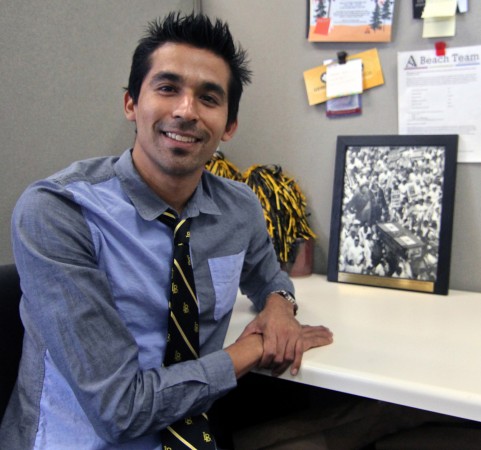
Jorge Sandoval is a junior psychology major at California State University, Long Beach. As an undocumented student, he’s worked to bring a dream center to the campus. Photo by Lucas Esposito / El Nuevo Sol.
By ALEXANDER SEBASTIÁN COREY
EL NUEVO SOL
College would have to wait.
With his mother on the verge of losing her home, Jorge Sandoval needed to make money fast. He quit Santa Ana Community College and began to search for more work to supplement his job at Circuit City.
A chance encounter with talent recruiters at a mall led to a two-year stint acting and modeling for independent films and brochures to pay the bills.
“I panicked. I wanted to do everything I could to take care of my mom. I’ll wear underwear, I’ll figure it out – you don’t have a choice,” said Sandoval, 27.
His story is not uncommon. It’s estimated that 65,000 undocumented youth graduate from U.S. high schools every year but only a small fraction make it to college. Those who do often face unique obstacles that can impede graduation.
In order to assist students like Sandoval, California State University, Long Beach recently approved a resource center for undocumented students and hired a full-time coordinator to run it.
“This student population is truly unique in regards to the constantly changing laws and policies that affect their education and everyday lives,” said Edgar Romo, who will serve as the center’s student success coordinator once it opens in January.
“Both the coordinator and the center will need to stay current on topics such as DACA renewals and driver’s licenses in order to provide sound and accurate information to students, the campus community, and the greater Long Beach area,” he added.
Yet while the CSU and community college systems serve the bulk of undocumented students in California, CSULB’s “Dream Center” – named for Dreamer students who qualify for in-state tuition at community colleges, CSUs and UCs under California’s AB540 – will only be the third such center in the entire CSU system. The first opened in April at Cal State Fullerton. In October, Cal State Los Angeles opened a Dreamers Resource center and hired a coordinator.
UC campuses, meanwhile, have seen a rapid expansion of similar centers systemwide, thanks in large part to a $5 million initiative spearheaded by UC President Janet Napolitano.
According to data from the California Student Aid Commission, for the 2014-2015 school year 2,925 undocumented CSU students received student aid, compared to 1,180 UC students. These numbers include only students who qualified for student aid through the California Dream Act. The actual number of undocumented students at CSU schools is likely higher.
Stephanie Thara is a spokesperson with the CSU Chancellor’s office. She noted that on most campuses the Educational Opportunity Program (EOP) centers – which provide support to first-generation, low-income students — have traditionally provided the bulk of services for undocumented students.
“Additionally, each CSU campus has a designated staff member in the admissions, financial aid and EOP offices to help AB 540 students achieve academic success at the CSU,” she added.
But for Romo, the significance of having a physical center for undocumented students goes beyond providing basic support.
“A center serves as not only a physical space dedicated to their unique needs as students, but as a commitment from the university to prioritize student success,” he said. “For those looking to attend California State University, Long Beach, it can signal a welcoming environment and a place of academic and personal support.”
Student advocacy
Undocumented student groups have been advocating for Dream Centers on individual CSU campuses, though progress has varied from one to the next.
Cal State Long Beach, Cal State Fullerton and Cal State Los Angeles have hired coordinators and approved centers this year, but other campuses are stuck in the planning stages. Cal State Northridge was given a space by its university for a Dream Center earlier this year, but a coordinator has yet to be hired.
Raquel Cetz Tamayo is a member of Dreams to be Heard, an undocumented student advocacy group at Cal State Northridge. Cetz Tamayo says the center was supposed to open this year, but its opening has been delayed until spring of 2015. The space is currently being used by students to study, but no programming or coordinator is in place.
“It’s empty, there’s no new furniture or anything,” said Cetz Tamayo. “It’s just there.”
At CSU Long Beach, talk of a Dream Center began a few years ago and was spearheaded by the campus’s undocumented student advocacy group, Future Underrepresented Educated Leaders (FUEL).
Eva Morelos is a student at CSU Long Beach and president of FUEL. She said the new Dream Center was stalled in part because of administrative changes. Over the last year, her club has worked with an interim and incoming university president to address the group’s needs.
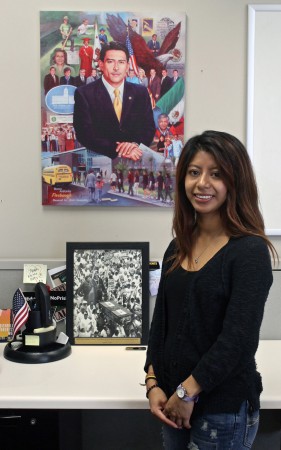
Eva Morelos, 23, senior student double major in Human Development and Sociology. Photo Credit: Lucas Esposito / El Nuevo Sol
Richard Haller, executive director of Associated Students, Inc., the student body government that approved the center last week, said a key move by FUEL was linking up with the student government on campus.
“It’s kind of hard to be just one or two students out in the wilderness,” said Haller. “But if you can connect to something that’s organized and institutionalized like student government, it gives you a better platform.”
The administration had always been supportive of the center; it was just a question of space, said Haller.
Like a ‘treasure hunt’
For Sandoval, the opening of the center is the culmination of years of personal and academic struggle.
After dropping out of Santa Ana, his aunt urged him to return to school. Since he was juggling several jobs, she agreed to help him pay for college – as long as he got straight As. Sandoval’s aunt passed away two years ago, but her supportive words endure. She told Sandoval to get educated and help others. “Use your big mouth,” she told him.
Back at Santa Ana College, Sandoval entered student government and was elected president. He also supported his two sisters after his mother was detained for driving without a license. She was later released, which Sandoval says was made possible thanks to support from school administrators and community members.
He’s now a junior at CSU Long Beach, where he is studying psychology while serving as secretary of student recruitment with Associated Students, Inc.. Sandoval, who played a role in helping to open the center, still spends much of his time advocating for undocumented students.
Reflecting on the center’s opening, he said it would benefit both undocumented students and the university.
“When you give to your community,” he said, “they give back.”
Tags: AB 540 Cal State LA California State University college csu CSU Fullerton CSU Long Beach CSU Northridge DACA Dream Act Dream Center dreamers Education Higher Ed higher education immigration undocumented University of California






